Application of Coffee Husk Ash as Partial Replacement of Fine Aggregate in Concrete
Abstract
:1. Introduction
2. Related Work
3. Materials and Methods
3.1. Fine and Coarse Aggregate
3.2. Concrete Mix Design and Proportions
3.3. Curing and Testing
4. Results and Discussion
4.1. Compressive Strength of Concrete with Ambient Curing
4.2. Compressive Strength of Concrete in Acidic and Alkaline Environment
4.3. Flexural and Split Tensile Strength of Concrete
4.4. Thermal Conductivity and Rapid Chloride Permeability Test
5. Conclusions
Author Contributions
Funding
Institutional Review Board Statement
Informed Consent Statement
Data Availability Statement
Conflicts of Interest
References
- Bekkeri, G.B.; Shetty, K.K.; Nayak, G. Synthesis of artificial aggregates and their impact on performance of concrete: A review. J. Mater. Cycles Waste Manag. 2023, 25, 1988–2011. [Google Scholar] [CrossRef]
- Gupta, S.; Kashani, A. Utilization of biochar from unwashed peanut shell in cementitious building materials—Effect on early age properties and environmental benefits. Fuel Process. Technol. 2021, 218, 106841. [Google Scholar] [CrossRef]
- Blesson, S.; Rao, A.U. Agro-industrial-based wastes as supplementary cementitious or alkali-activated binder material: A comprehensive review. Innov. Infrastruct. Solut. 2023, 8, 125. [Google Scholar] [CrossRef]
- Prasanna, S.; Pawan, A.; Kishan, A.; Shifa, G. A review paper on partial replacement of fine aggregate by different allied materials. Un artículo de revisión sobre el reemplazo parcial de agregado fino por diferentes materiales afines. Sustain. Agri Food Environ. Res. 2023, 12, 1–11. [Google Scholar]
- Bullard, J.W.; Jennings, H.M.; Livingston, R.A.; Nonat, A.; Scherer, G.W.; Schweitzer, J.S.; Scrivener, K.L.; Thomas, J.J. Mechanisms of cement hydration. Cem. Concr. Res. 2011, 41, 1208–1223. [Google Scholar] [CrossRef]
- Nagapan, S.; Rahman, I.A.; Asmi, A.; Memon, A.H.; Latif, I. Issues on construction waste: The need for sustainable waste management. In Proceedings of the CHUSER 2012—2012 IEEE Colloquium Humanities, Science Engineering Research, Kota Kinabalu, Malaysia, 3–4 December 2012; pp. 325–330. [Google Scholar] [CrossRef]
- Jin, R.; Yuan, H.; Chen, Q. Science mapping approach to assisting the review of construction and demolition waste management research published between 2009 and 2018. Resour. Conserv. Recycl. 2019, 140, 175–188. [Google Scholar] [CrossRef]
- Devadass, T. Experimental study on replacement of fine aggregate in concrete with dissimilar curing conditions. Case Stud. Constr. Mater. 2019, 11, e00245. [Google Scholar] [CrossRef]
- Vijay, P.G.; Dinesh; Kiran, M.; Avinash; Kumar, S. Experimental Study on Replacement of Fine Aggregate by Quarry Dust in concrete. Int. J. Struct. Civ. Eng. Res. 2014, 3, 110–117. [Google Scholar]
- Veerakumar, R.; Saravanakumar, R. A detailed study on partial replacement of fine aggregate with brick debris. Int. J. Civ. Eng. Technol. 2018, 9, 1028–1036. [Google Scholar]
- Jayadurgalakshmi, M.; Kandasamy, S. A comparative study on the various alternative materials for fine aggregate in concrete. Mater. Today Proc. 2022, 65, 1614–1622. [Google Scholar] [CrossRef]
- John, A.; John, E. Study on the partial replacement of fine aggregate using induction furnace slag. Am. J. Eng. Res. 2013, 4, 1–5. [Google Scholar]
- Padmapriya, R.; Tharian, J.A.; Thirunalasundari, T. Coffee waste management—An overview. Int. J. Curr. Sci. 2013, 9, 83–91. [Google Scholar]
- Blesson, S.; Rao, A.U.; Bhandary, R.P.; Shetty, P.P.; Thomas, B.S. Comparative characteristics assessment of calcined and uncalcined agro-based waste ash with GGBS and its application in an alkali-activated binder system calcined and uncalcined agro-based waste ash alkali-activated binder system. Cogent Eng. 2023, 10, 2220483. [Google Scholar] [CrossRef]
- Janissen, B.; Huynh, T. Chemical composition and value-adding applications of coffee industry by-products: A review. Resour. Conserv. Recycl. 2018, 128, 110–117. [Google Scholar] [CrossRef]
- Sime, W.; Kasirajan, R.; Latebo, S.; Mohammed, A.; Seraw, E. Coffee Husk Highly Available in Ethiopia as an Alternative Waste Source for Biofuel Production. Int. J. Sci. Eng. Res. 2017, 8, 1874–1880. Available online: http://www.ijser.org (accessed on 18 January 2023).
- Massaya, J.; Pereira, A.P.; Mills-Lamptey, B.; Benjamin, J.; Chuck, C.J. Conceptualization of a spent coffee grounds biorefinery: A review of existing valorisation approaches. Food Bioprod. Process. 2019, 118, 149–166. [Google Scholar] [CrossRef]
- Munirwan, R.P.; Taib, A.M.; Taha, M.R.; Rahman, N.A.; Munirwansyah, M. Utilization of coffee husk ash for soil stabilization: A systematic review. Phys. Chem. Earth 2022, 128, 103252. [Google Scholar] [CrossRef]
- Espíndola-Gonzalez, A.; Martínez-Hernández, A.L.; Angeles-Chávez, C.; Castaño, V.M.; Velasco-Santos, C. Novel Crystalline SiO2 Nanoparticles via Annelids Bioprocessing of Agro-Industrial Wastes. Nanoscale Res. Lett. 2010, 5, 1408–1417. [Google Scholar] [CrossRef]
- Shetty, P.P.; Rao, A.U.; Pai, B.H.V.; Kamath, M.V. Performance of High-Strength Concrete with the Effects of Seashell Powder as Binder Replacement and Waste Glass Powder as Fine Aggregate. J. Compos. Sci. 2023, 7, 92. [Google Scholar] [CrossRef]
- Kamath, M.; Prashant, S.; Ralegaonkar, R. Microstructure Properties of Popular Alkali-Activated Pastes Cured in Ambient Temperature. Buildings 2023, 13, 858. [Google Scholar] [CrossRef]
- Tran, N.Q.; Hoy, M.; Suddeepong, A.; Horpibulsuk, S.; Kantathum, K.; Arulrajah, A. Improved mechanical and microstructure of cement-stabilized lateritic soil using recycled materials replacement and natural rubber latex for pavement applications. Constr. Build. Mater. 2022, 347, 128547. [Google Scholar] [CrossRef]
- Lima, F.S.; Gomes, T.C.F.; de Moraes, J.C.B. Novel one-part alkali-activated binder produced with coffee husk ash. Mater. Lett. 2022, 313, 2–5. [Google Scholar] [CrossRef]
- Lin, L.K.; Kuo, T.M.; Hsu, Y.S. The application and evaluation research of coffee residue ash into mortar. J. Mater. Cycles Waste Manag. 2016, 18, 541–551. [Google Scholar] [CrossRef]
- Gedefaw, A.; Yifru, B.W.; Endale, S.A.; Habtegebreal, B.T.; Yehualaw, M.D. Experimental Investigation on the Effects of Coffee Husk Ash as Partial Replacement of Cement on Concrete Properties. Adv. Mater. Sci. Eng. 2022, 2022, 4175460. [Google Scholar] [CrossRef]
- Supar, K.; Rani, F.A.A.; Mazlan, N.L.; Musa, M.K. Partial Replacement of Fine Aggregate Using Waste Materials in Concrete as Roof Tile: A Review. IOP Conf. Ser. Mater. Sci. Eng. 2021, 1200, 012008. [Google Scholar] [CrossRef]
- Ismail, Z.Z.; AL-Hashmi, E.A. Recycling of waste glass as a partial replacement for fine aggregate in concrete. Waste Manag. 2009, 29, 655–659. [Google Scholar] [CrossRef] [PubMed]
- Modani, P.O.; Vyawahare, M.R. Utilization of bagasse ash as a partial replacement of fine aggregate in concrete. Procedia Eng. 2013, 51, 25–29. [Google Scholar] [CrossRef]
- Bai, Y.; Darcy, F.; Basheer, P.A.M. Strength and drying shrinkage properties of concrete containing furnace bottom ash as fine aggregate. Constr. Build. Mater. 2005, 19, 691–697. [Google Scholar] [CrossRef]
- Gupta, T.; Chaudhary, S.; Sharma, R.K. Assessment of mechanical and durability properties of concrete containing waste rubber tire as fine aggregate. Constr. Build. Mater. 2014, 73, 562–574. [Google Scholar] [CrossRef]
- Aggarwal, Y.; Siddique, R. Microstructure and properties of concrete using bottom ash and waste foundry sand as partial replacement of fine aggregates. Constr. Build. Mater. 2014, 54, 210–223. [Google Scholar] [CrossRef]
- Singh, G.; Siddique, R. Effect of iron slag as partial replacement of fine aggregates on the durability characteristics of self-compacting concrete. Constr. Build. Mater. 2016, 128, 88–95. [Google Scholar] [CrossRef]
- Vardhan, K.; Siddique, R.; Goyal, S. Influence of marble waste as partial replacement of fine aggregates on strength and drying shrinkage of concrete. Constr. Build. Mater. 2019, 228, 116730. [Google Scholar] [CrossRef]
- Karalar, M.; Bilir, T.; Çavuşlu, M.; Özkiliç, Y.O.; Sabri, M.M.S. Use of Recycled Coal Bottom Ash in Reinforced Concrete Beams as Replacement for Aggregate. Front. Mater. 2022, 9, 1064604. [Google Scholar] [CrossRef]
- Qaidi, S.; Al-Kamaki, Y.; Hakeem, I.; Dulaimi, A.F.; Özkılıç, Y.; Sabri, M.; Sergeev, V. Investigation of the physical-mechanical properties and durability of high-strength concrete with recycled PET as a partial replacement for fine aggregates. Front. Mater. 2023, 10, 1101146. [Google Scholar] [CrossRef]
- Çelik, A.I.; Özkılıç, Y.O.; Zeybek, Ö.; Karalar, M.; Qaidi, S.; Ahmad, J.; Burduhos-Nergis, D.D.; Bejinariu, C. Mechanical Behavior of Crushed Waste Glass as Replacement of Aggregates. Materials 2022, 15, 8093. [Google Scholar] [CrossRef] [PubMed]
- Basaran, B.; Kalkan, I.; Aksoylu, C.; Özkılıç, Y.O.; Sabri, M.M.S. Effects of Waste Powder, Fine and Coarse Marble Aggregates on Concrete Compressive Strength. Sustainability 2022, 14, 14388. [Google Scholar] [CrossRef]
- Rao, A.U.; Bh, R.; Maddodi, B.; Tantri, A.; Shenoy, S.; Kamath, M.; Shetty, R.S. Performance Evaluation of Hybrid Glass Wastes Incorporated Concrete. Eng. Sci. 2022, 20, 188–198. [Google Scholar] [CrossRef]
- ASTM C33/C33M-18; Standard Specification for Concrete Aggregates. American Society for Testing and Material: West Conshohocken, PA, USA, 2010. [CrossRef]
- IS-383-2016; Coarse and Fine Aggregate for Concrete-Specification. Bureau Indian Standards: New Delhi, India, 2016.
- Dash, M.K.; Patro, S.K.; Rath, A.K. Sustainable use of industrial-waste as partial replacement of fine aggregate for preparation of concrete—A review. Int. J. Sustain. Built Environ. 2016, 5, 484–516. [Google Scholar] [CrossRef]
- IS-10262-2019; Concrete Mix Proportioning-Guidelines (Second Revision). Bureau Indian Standards: New Delhi, India, 2019. Available online: www.standardsbis.in (accessed on 23 January 2023).
- IS-10086-1982; Specification for Molds for Use in Tests of Cement and Concrete. Bureau Indian Standards: New Delhi, India, 1982.
- IS-516-2021; Hardened Concrete-Methods of Test Part 1 Testing of Strength of Hardened Concrete Section 1 Compressive, Flexural and Split Tensile Strength (First Revision). Bureau Indian Standards: New Delhi, India, 2021. Available online: www.standardsbis.in (accessed on 23 October 2022).
- Asadi, I.; Shafigh, P.; Hassan, Z.F.B.A.; Mahyuddin, N.B. Thermal conductivity of concrete—A review. J. Build. Eng. 2018, 20, 81–93. [Google Scholar] [CrossRef]
- IS-3346-1980; Method of Determination of Thermal Conductivity of Thermal Insulation Materials (Two Slab, Guarded Hot-Plate Method). Bureau Indian Standards: New Delhi, India, 1980. Available online: www.standardsbis.in (accessed on 23 October 2022).
- ASTM C1202-19; Standard Test Method for Electrical Indication of Concrete’s Ability to Resist Chloride Ion Penetration 1. American Society for Testing and Material: West Conshohocken, PA, USA, 2017. [CrossRef]
- IS-516-1959; Concrete-Strength-Test. Bureau Indian Standards: New Delhi, India, 1959.
- Demissew, A.; Fufa, F.; Assefa, S. Partial replacement of cement by coffee husk ash for C-25 concrete production. J. Civ. Eng. Sci. Technol. 2019, 10, 12–21. [Google Scholar] [CrossRef]
- Ahmed, A.; Kamau, J.; Pone, J.; Hyndman, F.; Fitriani, H. Chemical Reactions in Pozzolanic Concrete. Mod. Approaches Mater. Sci. 2019, 1, 128–133. [Google Scholar] [CrossRef]
- Aliyu, I.; Sulaiman, T.A.; Muhammad, A.; Kaura, J.M. Effect of Sulphuric Acid on the Compressive Strength of Concrete with Quarry Dust as Partial Replacement of Fine Aggregate. FUDMA J. Sci. 2020, 4, 553–559. Available online: https://www.researchgate.net/publication/340455044 (accessed on 20 March 2023).
- IS-456-2000; Indian Standard Plain and Reinforced Concrete-Code of Practice (Fourth Revision). Bureau of Indian Standards: New Delhi, India, 2000.
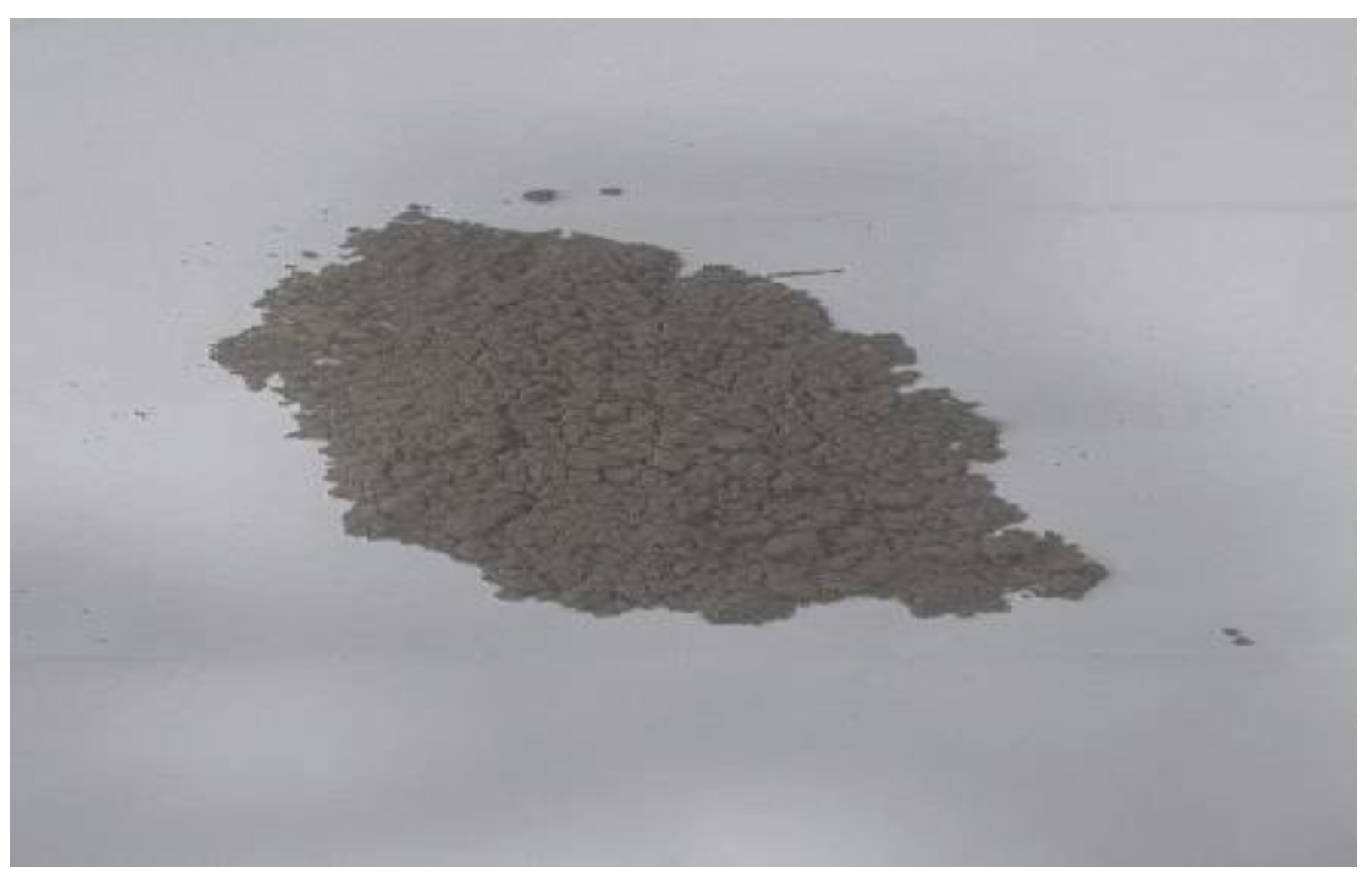
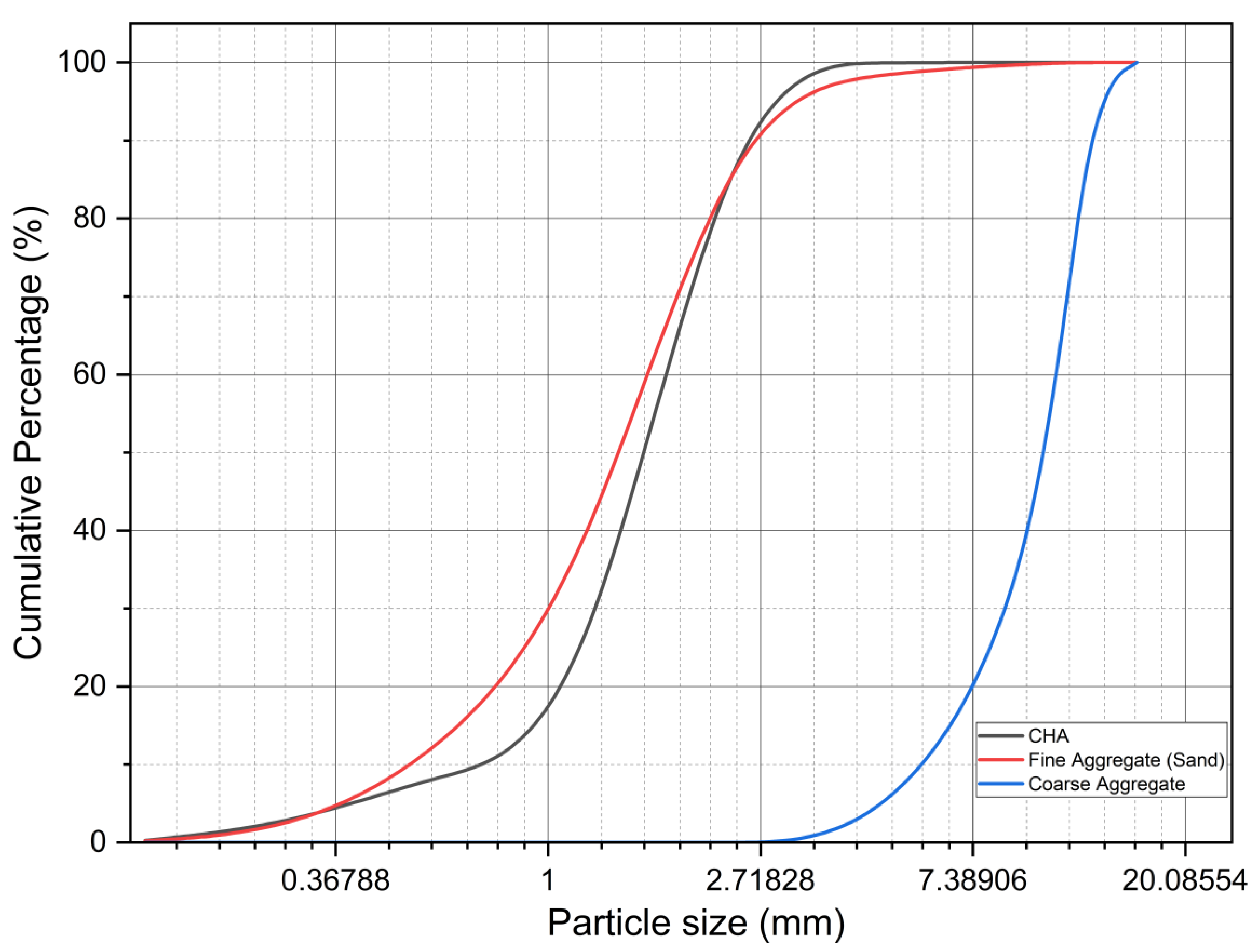
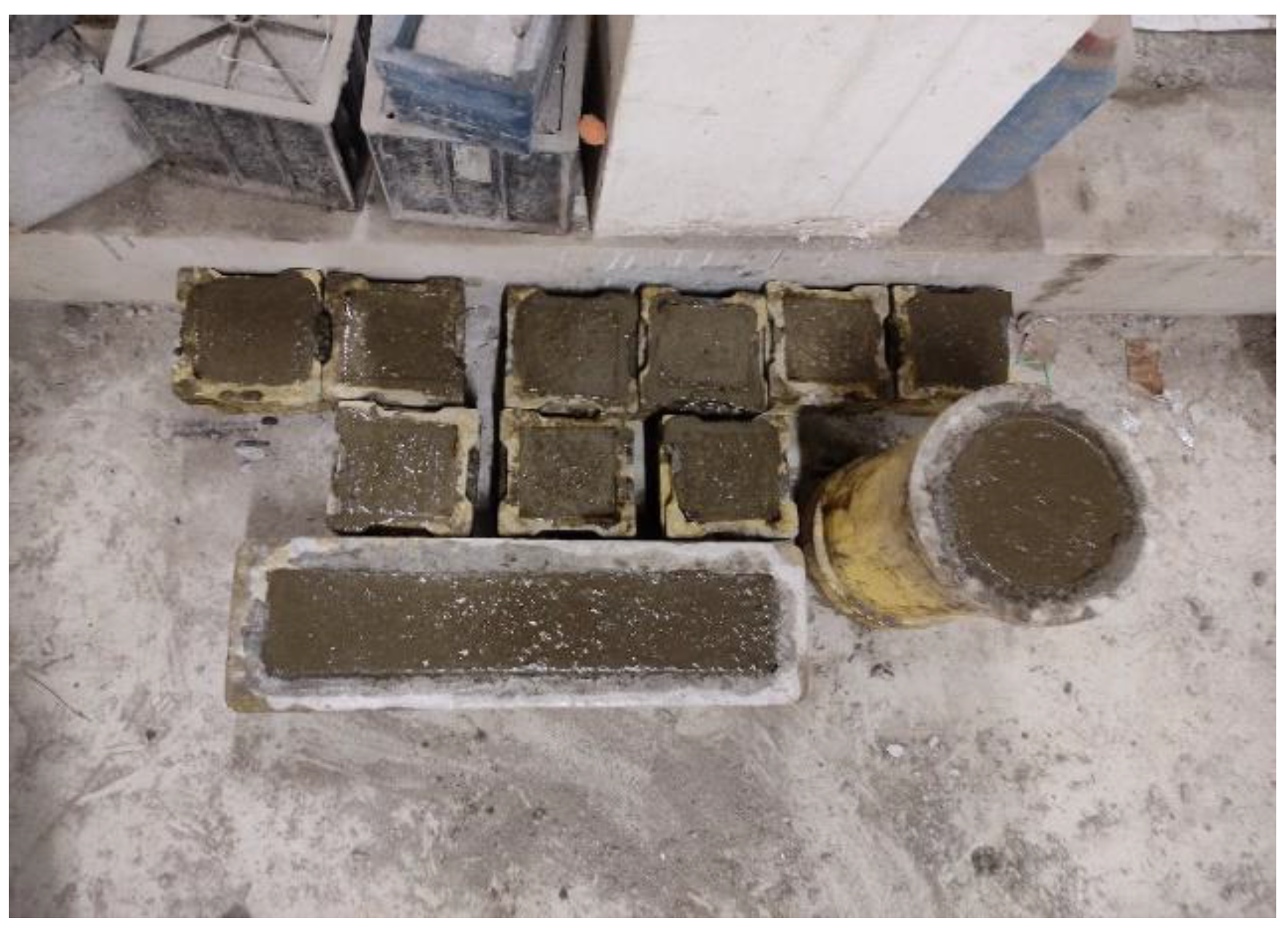

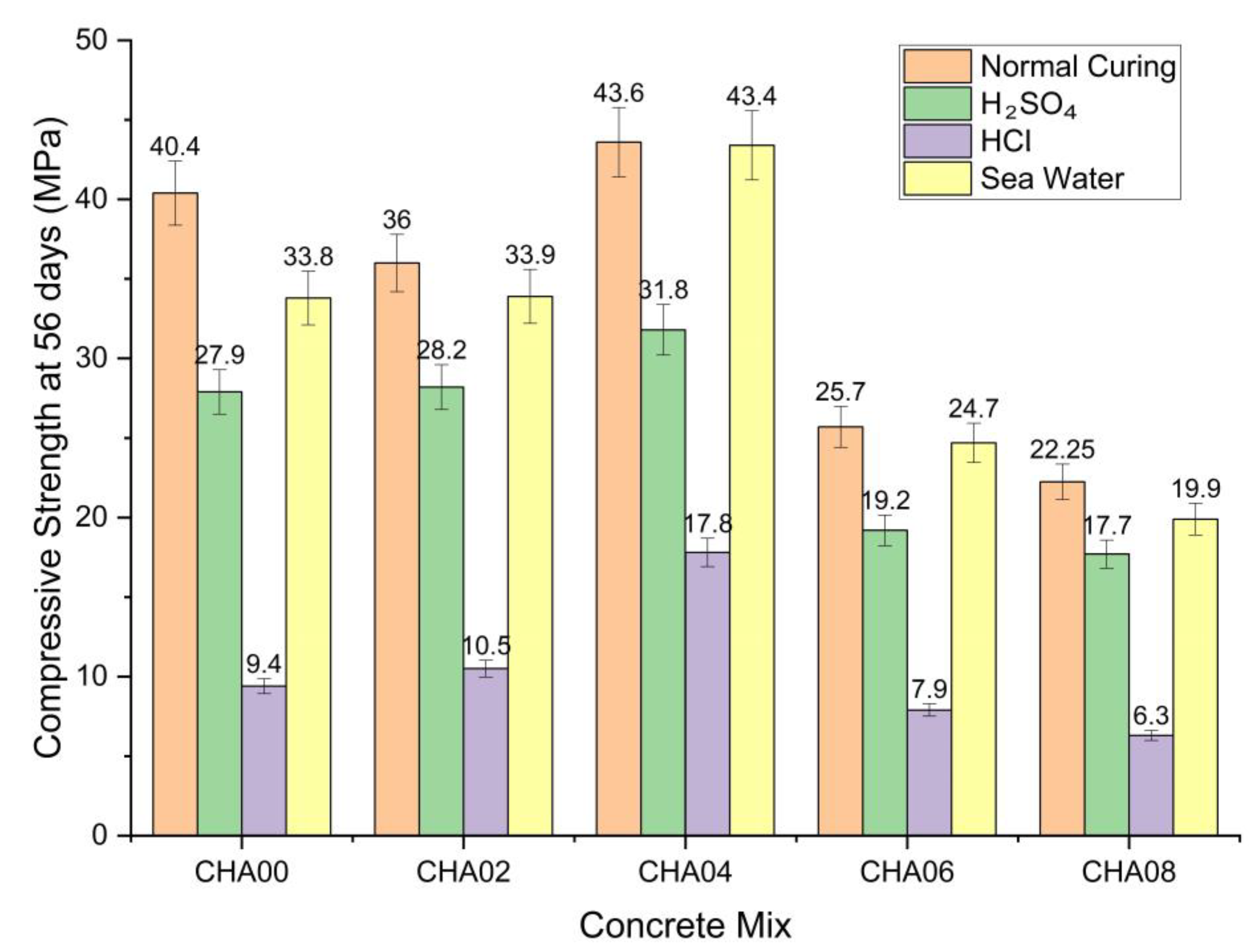


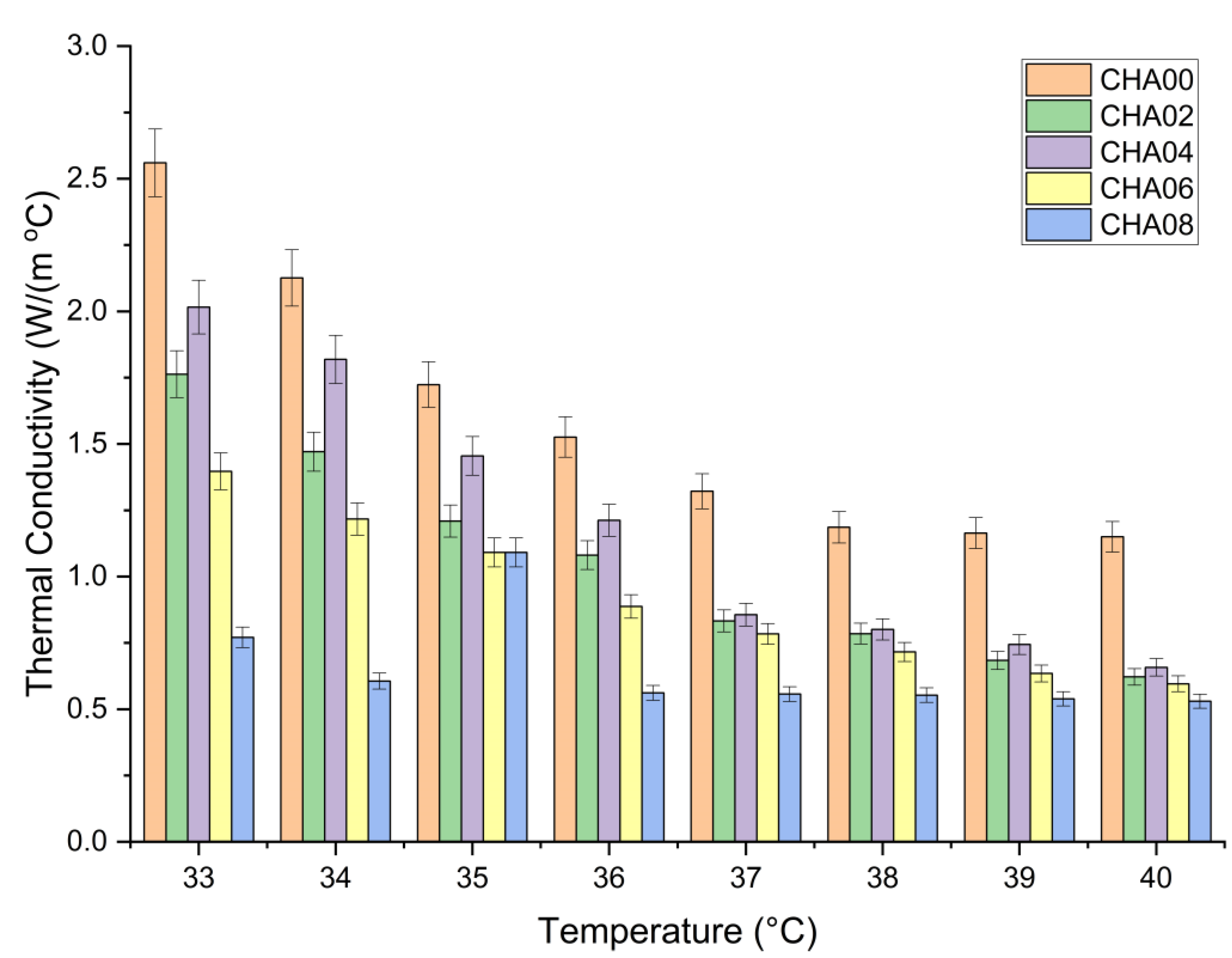


| Component | OPC 53 |
|---|---|
| CaO | 58.66 |
| SiO2 | 21.27 |
| Al2O3 | 8.79 |
| Fe2O3 | 3.56 |
| MgO | 1.94 |
| K2O | - |
| Na2O | - |
| SO3 | 2.52 |
| TiO2 | 1.35 |
| LOI | 1.48 |
| Specific gravity | 3.12 |
| Specific surface area/fineness (m2/g) | 0.33 |
| Components & Properties | Amounts |
|---|---|
| CaO | 17.611% |
| SiO2 | 15.00% |
| Al2O3 | 0.744% |
| Fe2O3 | 2.727% |
| K2O | 61.099% |
| Na2O | 0.00% |
| MgO | 0.494% |
| SO3 | 0.977% |
| MnO2 | 0.302% |
| TiO2 | 0.421% |
| Loss of ignition | - |
| Specific gravity | 2.5 |
| Specific surface area/fineness (m2/g) | 1.70 |
| Sl.No | Mix ID | Replacement Levels | Cement | FA | Coffee Husk Ash | CA | w/c Ratio |
|---|---|---|---|---|---|---|---|
| 1 | CHA00 | 0% | 1 | 1.66 | – | 1.99 | 0.45 |
| 2 | CHA02 | 2% | 1 | 1.62 | 0.04 | 1.99 | 0.457 |
| 3 | CHA04 | 4% | 1 | 1.59 | 0.07 | 1.99 | 0.462 |
| 4 | CHA06 | 6% | 1 | 1.56 | 0.10 | 1.99 | 0.467 |
| 5 | CHA08 | 8% | 1 | 1.52 | 0.14 | 1.99 | 0.473 |
| Replacement Levels with CHA | Slump in (mm) |
|---|---|
| Normal concrete | 50 |
| 2% replacement | 48 |
| 4% replacement | 42 |
| 6% replacement | 34 |
| 8% replacement | 25 |
Disclaimer/Publisher’s Note: The statements, opinions and data contained in all publications are solely those of the individual author(s) and contributor(s) and not of MDPI and/or the editor(s). MDPI and/or the editor(s) disclaim responsibility for any injury to people or property resulting from any ideas, methods, instructions or products referred to in the content. |
© 2023 by the authors. Licensee MDPI, Basel, Switzerland. This article is an open access article distributed under the terms and conditions of the Creative Commons Attribution (CC BY) license (https://creativecommons.org/licenses/by/4.0/).
Share and Cite
Bhandary, R.P.; Rao, A.U.; Shetty, P.P.; Blesson, S.; Thomas, B.S. Application of Coffee Husk Ash as Partial Replacement of Fine Aggregate in Concrete. Sustainability 2023, 15, 13328. https://doi.org/10.3390/su151813328
Bhandary RP, Rao AU, Shetty PP, Blesson S, Thomas BS. Application of Coffee Husk Ash as Partial Replacement of Fine Aggregate in Concrete. Sustainability. 2023; 15(18):13328. https://doi.org/10.3390/su151813328
Chicago/Turabian StyleBhandary, Radhika P., Asha U. Rao, Prathibha P. Shetty, S. Blesson, and Blessen Skariah Thomas. 2023. "Application of Coffee Husk Ash as Partial Replacement of Fine Aggregate in Concrete" Sustainability 15, no. 18: 13328. https://doi.org/10.3390/su151813328







